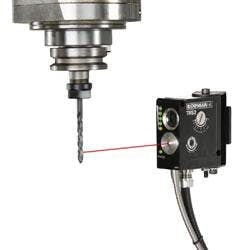Broken Tool Detection System
Renishaw halves the hardware and applies unique tool recognition electronics in the new, second-generation TRS2 broken tool detection system, making precise laser checking affordable and practical for all kinds of machine tools. Industry-first "one box" design combines the laser source and detection electronics in a single compact unit just 83mm high x 38mm wide x 73mm deep (3.27" x 1.50" x 2.87"), enabling easy mounting outside the work zone, safe from collision. The TRS2 can detect a whole range of solid center tools, including drills, taps, reamers, slot drills, standard and ball nose end mills, and now even gun drills. Detection typically takes only a second. The system can process tools as small as 0.2 mm, while screening out chip and coolant mis-readings. The versatile TRS2 can be easily fitted to everything from mini drilling systems for electronics boards to large machining centers. The laser system offers wide detection range — 0.3m to 2.0m/13" to 80" — while innovativeToolwise™ electronics technology reliably distinguishes good tools from broken tools without mis-readings caused by coolant and chips. Unique to Renishaw, the Toolwise technology analyzes reflected light patterns from the rotating tool as it enters the beam, rejecting random light patterns created by coolant or chips. Tool edges generate a regular light pattern as the tool spins, while chips and coolant give random reflections. A repeating pattern represents a tool present and whole. A non-repeating pattern indicates a tool broken. The advanced electronics can detect and process reflections off both bright and dark tools. New on the TRS2, monitoring can be provided at three different tool rotation speeds — 5000 rpm, 1000 rpm and 200 rpm — to cover a wide range of applications and tooling. Used for high-speed tools, 5000 rpm is the default speed and gives the shortest cycle time. Intermediate 1000 rpm can be used for tools rated for less than 5000 rpm, particularly large, heavier tools. The slowest speed, 200 rpm is intended for gun drills. Unlike conventional two-part systems, with the laser beam unit on one side and a detector/receiver on the opposite side, the single-box TRS2 gives great mounting flexibility to optimize working space and processing routines. Simple integration eliminates need for special alignment hardware, complex mounting brackets, or software-based calibration and alignment cycles. A five-tiered LED enables fast set-up and provides a visual indication of signal strength. Macro-based software is supplied with each system supporting a wide range of controllers. No M codes are required for operation. The TRS2 can be mounted to any rigid surface of the machine. Positioning of the TRS2 relative to the tool is not critical and does not require accurate alignment with the machine's axes. The tool recognition process is fast, usually taking about one second. A flexible setup process allows a user-defined broken tool detection point to be established within the machine's envelope. Detection is performed when a rotating tool reaches this point. The TRS2 is supplied with a filter regulator assembly that delivers a constant supply of clean dry air protecting the laser against contaminants. This proven protection method was adapted from Renishaw's Non-Contact (NC) family of laser toolsetters. • Minimum tool diameter Each TRS2 unit is tested with a Ø0.5 mm dark coated • drill at a range of 350 mm (14 in). • Test conditions: Dry tool, spinning at 5000 rpm, which • must be detected by the TRS2 within 1 s. • Spindle Speed Operates with tool spinning at 200 rpm, 1000 rpm or • 5000 rpm. 5000 rpm is for use with high speed tools. It is • the default speed and gives the shortest cycle times. • 1000 rpm is for use with tools that cannot rotate at • 5000 rpm. 200 rpm is for use only with gun drills. • Range TRS2 can be used to detect tools at a distance of • between 300 mm and 2 m, but it is optimised for • use between 300 mm and 1 m. • Working temperature 5° C to 50° C • Storage temperature -10° C to 70° C • Pneumatic supply Ø4 mm air pipe. Recommended air pressure: • 2 bar (29 psi) to 4.5 bar (65.25 psi), dependent on • air pipe length. • Air supply to the TRS2 air regulator unit must conform • to ISO 8573-1: Class 5 particles and moisture free. • Air supply to the TRS2 unit must conform to • ISO 8573-1: Air quality of class 1.7.2. • Air blast For optimum performance at 200 rpm and 1000 rpm, the • optional Renishaw air blast is recommended. • This consists of mounting plate, air nozzle, air pipe and • air fittings. A solenoid valve is also available to turn the • air on and off. • IP rating The electronics are sealed to IPX8. • Life Tested to > 1 million on/off cycles. • Weight 0.75 kg (1.65 lb), including 10 m of cable. • Dimensions Height: 83 mm (3.27 in) • Width: 38 mm (1.50 in) • Depth: 73 mm (2.87 in) • Mounting Mounting bracket provided, with M6 clearance slots. • Alternative mounting arrangement is provided by M4 • clearance holes in the product housing. • Input voltage 11 Vdc to 30 Vdc. • Current consumption Typically less than 65 mA at 12 Vdc. • Cable 5 core plus screen cable. Each core 18/0.1 insulated. • Ø5.0 mm (0.20 in) x 10 m (32 ft) • Output Solid state relay (SSR) normally open/normally closed • contact max. 40 mA (fused at 50 mA).
